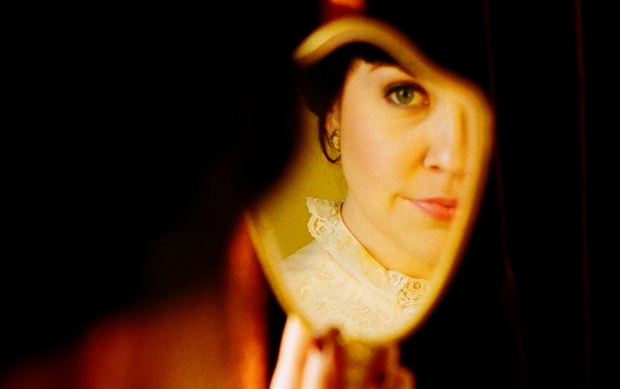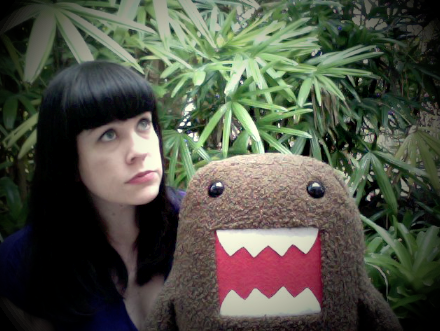According to Mike Belsito, who runs a funeral planning website, the word “death” is searched for on Google 68,000,000 times per month. “For perspective,” he writes, “that’s twice as much as the search results for the word ‘marriage’—and more than thirteen times as much as the results for ‘happiness.'” When the Tricycle staff were planning our current issue, which features a large special section on death and dying, we didn’t know these numbers. But we’re happy to learn that we’re not the only ones interested in our own mortality.
Caitlin Doughty, a licensed funeral director and mortician in Los Angeles, California, has made that interest her life’s work and mission. In Caitlin’s words, she was “born on a balmy August evening on the very un-morbid shores of O’ahu, Hawai’i.” Because Hawai’i isn’t the best backdrop for a teenager with a natural fascination with death, Caitlin chose to attend college in the colder and rainier setting of Illinois, where she majored in Medieval History at the University of Chicago. After graduating, she moved to California, where she began her first job in the death industry as a crematory operator. Since then, she’s worked as a funeral arranger and a body van transport driver before becoming a funeral director and mortician.
In 2011, she founded the Order of the Good Death, a collective of death industry professionals and artists who are devoted to bringing a death-phobic culture to grips with their own mortality. Caitlin’s “Ask a Mortician” series on YouTube, in which she fields questions about death with personality, verve, and the help of some goofy animations, has hundreds of thousands of views. It turns out that Tricycle—and Caitlin—aren’t the only ones who want to be prepared when the Grim Reaper comes knockin’.

When did your interest in death start? Why did you decide to become a mortician? I was interested in death from a very early age. Most children have morbid fascinations that get trampled on by adults. “Don’t touch that dead bird!” or “Don’t ask any questions about where your grandfather went!” Because adults fear it so much, children don’t get to live out their very natural interest in death.
I decided to become a mortician because death is like a rabbit hole. The more you learn the more fascinated you become. I wanted to know everything there was to know—not just academically. So I looked for a job at a crematory before returning to school for a mortuary science degree. That was five years ago.
How has working in the death industry—and being very “hands-on” with dead bodies—affected the way you view death in general as well as your own death in particular? There is nothing that can replace hands-on experience if you are trying to become more comfortable with death. Humans don’t really believe anything until they see it. When you’re up close with the dead, your own death all of a sudden becomes drastically more real. Corpses are the ultimate symbol of your mortality. You can either hide from it, or you can find ways to embrace it.
How would you motivate someone to meditate on death, taking into account that many are averse to such patterns of thinking? Think about death because doing it is like eating a vegetable. Thinking about it might not be fun (at first) but it’s good for you. It helps you to detach from the idea that your body and life are more important than anyone else’s. Carrots might not be as delicious as cupcakes, but over the long haul, meditating on your mortality has incredibly positive effects on your relationships with yourself, your body, and other people.
What might be the best avenues for reintroducing the important issue of death—the sight of it, its contemplation, and acceptance—back into mainstream, visible culture? I’d love to go back to a time during which there were tight-knit communities and people died at home, taken care of by their families. But I know that such a thing would not be realistic from where we are culturally. We have to work within the framework of culture. This means using the Internet, using art, using video, using technology. The artists I work with in the Order of the Good Death combine artistic ideas about death interaction with innovation. And that’s the kind of work that people get excited about. The goal is to get people excited about death—to make it culturally acceptable to be excited about the possibilities of death.
We’re so used to being anxious about death that we forget that other cultures aren’t so terrified of it. What’s one culture you know of whose death rituals you particularly admire for their brave acceptance of death? There are so many to pick from. I’ve been reading a lot lately about the turning of the bones festival in Madagascar. They take their bones from their crypts, dance with them, and re-wrap them in fresh shrouds. They’re one of many cultures that believe that decomposition is necessary for the soul to fully transition. They wouldn’t dream of trying to stop decomposition like we do in the Western world.
Why are we so terrified of death, anyway? In the late 19th century two big changes occurred: capitalism and sanitation.
Men who were coffin sellers decided they were going to rent out funeral carriages, too. Then they decided they were going to be embalmers. Then they decided they were going to have funeral homes where a family could pay them to take care of absolutely everything.
This was also the time in which we figured out that bacteria and germs were the reason why cities were dirty and people were getting sick. Hospitals were built and people began to die there under a doctor’s care.
A person used to die at home and then be kept at home for a funeral, but during this period that model was replaced with people dying in a hospital and being prepared at a funeral home. The family used to be involved in everything and now they are involved in nothing. That distance is what makes death so terrifying.
You said in one of your “Ask a Mortician” videos that your choice of funerary arrangements would be “Corpse, hole, ground, dump.” Why? For whatever reason, it is what makes me feel comfortable with death. Some people like the idea of having scientific tests done on their corpses, some people like a comfy, warm cremation pyre, some people like a big sturdy coffin to stay protected. For me, the idea of my corpse going back into the earth is very comforting. I don’t think disposal of humans should be any fancier than disposal of animals. If I eat animals during my life, I’d like to return the favor when I die.
 What’s one thing that everyone should know about the death industry in the U.S.? That embalming is not legally required. Many funeral directors will say it’s required, not trying to scam you, but because they legitimately think it is the law. They’ve just been doing it that way for so long that they’ve forgotten it’s totally optional.
What’s one thing that everyone should know about the death industry in the U.S.? That embalming is not legally required. Many funeral directors will say it’s required, not trying to scam you, but because they legitimately think it is the law. They’ve just been doing it that way for so long that they’ve forgotten it’s totally optional.
Embalming is a very invasive process of chemically preserving the body. I certainly wouldn’t tell a family not to embalm, as it’s not my place and I’m a big proponent of choosing what makes you most comfortable with death. I would just say that you should make sure you know what embalming actually is before you agree to it.
You said in one of your “Ask a Mortician” videos that you have lots of crazy stories about what goes on in the cremation process. Can you tell us one? I was thinking the other day about an elderly Chinese woman who I cremated fairly early on in my career. She had a large jade bracelet on, which I didn’t see when I put her in the cremation machine. Because of the super high heat of the cremation chamber it burst into beautiful green shards that mixed with her bones. I was terrified the family may have wanted it back as an heirloom and that I had screwed up. Fortunately they had wanted the bracelet to stay with her.
To read our current issue’s special section on dying and death, click here.